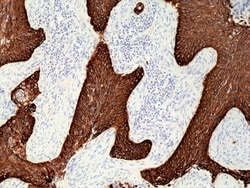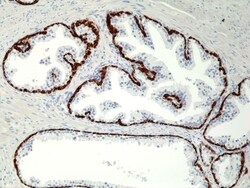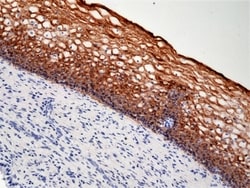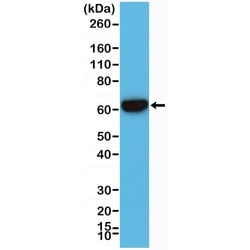Learn More
Invitrogen™ Cytokeratin 5/6 Recombinant Rabbit Monoclonal Antibody (RM341)


Rabbit Recombinant Monoclonal Antibody
Supplier: Invitrogen™ MA533043
Description
Specificity: reacts to both human CK-5 (Cytokeratin 5) and CK-6 (Cytokeratin 6). Recombinant rabbit monoclonal antibodies are produced using in vitro expression systems. The expression systems are developed by cloning in the specific antibody DNA sequences from immunoreactive rabbits. Then, individual clones are screened to select the best candidates for production. The advantages of using recombinant rabbit monoclonal antibodies include: better specificity and sensitivity, lot-to-lot consistency, animal origin-free formulations, and broader immunoreactivity to diverse targets due to larger rabbit immune repertoire.
The protein encoded by this gene is a member of the keratin gene family. The type II cytokeratins consist of basic or neutral proteins which are arranged in pairs of heterotypic keratin chains coexpressed during differentiation of simple and stratified epithelial tissues. This type II cytokeratin is specifically expressed in the basal layer of the epidermis with family member KRT14. Mutations in these genes have been associated with a complex of diseases termed epidermolysis bullosa simplex. The type II cytokeratins are clustered in a region of chromosome 12q12-q13.
Specifications
| Cytokeratin 5/6 | |
| Recombinant Monoclonal | |
| 0.1 mg/mL | |
| PBS with 1% BSA, 50% glycerol and 0.09% sodium azide | |
| P02538, P04259, P13647 | |
| KRT5, KRT6A, KRT6B | |
| A peptide corresponding to the C-terminus of Human Cytokeratin 5. | |
| 100 μL | |
| Primary | |
| Human | |
| Antibody | |
| IgG |
| Immunohistochemistry (Paraffin), Western Blot | |
| RM341 | |
| Unconjugated | |
| KRT5 | |
| 2310016L08Rik; 3300001P10Rik; 58 kDa cytokeratin; 60-kDa keratin; AW146334; CK5; CK-5; CK6A; CK-6A; CK6C; CK-6C; CK6D; CK-6D; CK-6E; cytokeratin 5; cytokeratin 6A; cytokeratin 6C; cytokeratin 6D; cytokeratin-5; Cytokeratin-6A; cytokeratin-6C; Cytokeratin-6D; cytokeratin-6E; DDD; DDD1; EBS2; epidermolysis bullosa simplex 2 Dowling-Meara/Kobner/Weber-Cockayne types; Hom s 5; K5; K6A; K6a keratin; K6C; K6D; kamp-keratin derived antimicrobial peptide; KDAMP; Ker2; keratin 5; keratin 5 (epidermolysis bullosa simplex Dowling-Meara/Kobner/Weber-Cockayne types); keratin 5 (epidermolysis bullosa simplex, Dowling-Meara/Kobner/Weber-Cockayne types); keratin 5, type II; keratin 6A; keratin 6A, , type II; keratin 6A, type II; keratin complex 2, basic, gene 5; keratin complex 2, basic, gene 6a; keratin complex 2, basic, gene 6c; keratin complex 2, gene 6a; keratin K6; keratin K6h; keratin, epidermal type II, K6A; keratin, type II cytoskeletal 5; Keratin, type II cytoskeletal 6A; keratin, type II cytoskeletal 6C; keratin-5; keratin-6A; Keratin-6-alpha; keratin-6C; Krt2-5; Krt2-6; Krt2-6a; Krt2-6c; krt5; KRT5A; Krt6; Krt6a; KRT6C; KRT6D; LOC683313; mK6[a]; MK6a; mK6-alpha; PC3; Sak57; similar to keratin complex 2, basic, gene 6a; Tfip8; tuftelin interacting protein 8; type-II keratin Kb12; type-II keratin Kb5; Type-II keratin Kb6 | |
| Rabbit | |
| Protein A | |
| RUO | |
| 3852, 3853, 3854 | |
| -20°C | |
| Liquid |
Your input is important to us. Please complete this form to provide feedback related to the content on this product.



